|

HOME |
ABOUT | INDEX |
NEWS |
FACEBOOK |
CONTACT
ARCHAIC
Antique
| Vintage | Historic
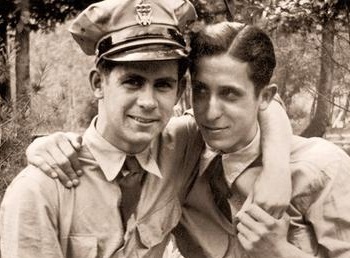
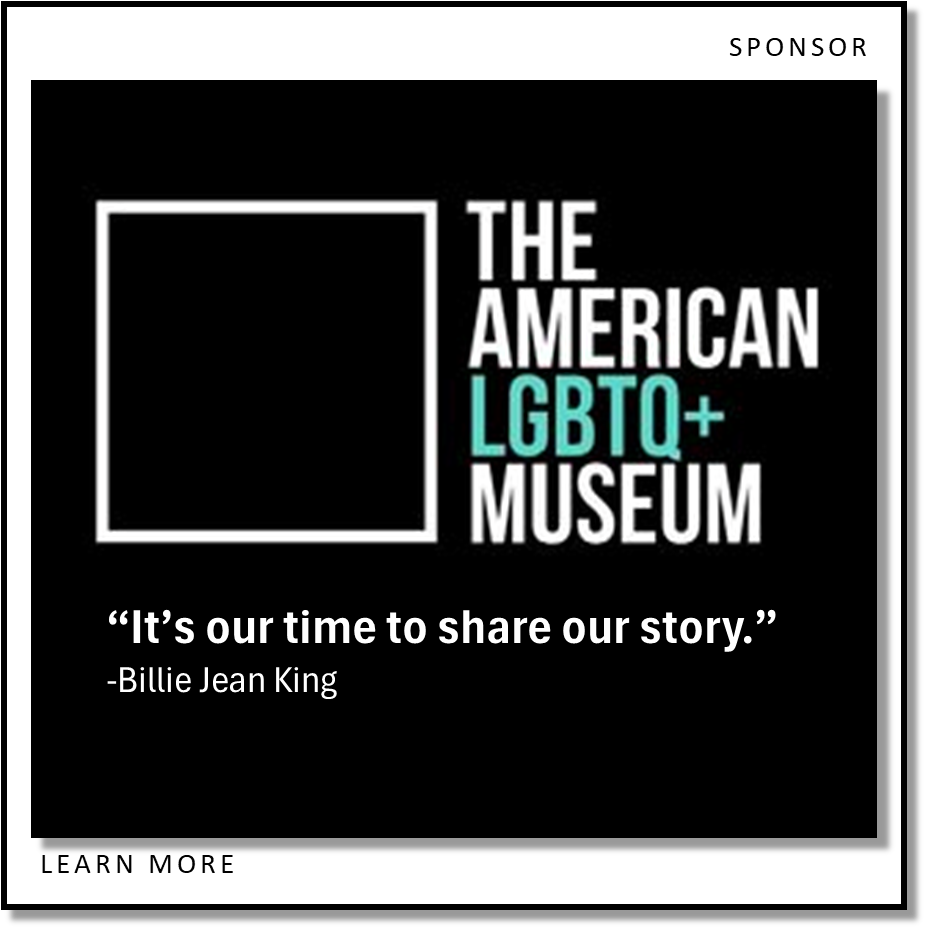
Famous LGBTQ People
LGBTQ Biographies
Celebrate Pride
Symbols and Flags
Historical Perspective
Profile|Culture|Community

Old Timey Terms
Compared
to bygone times, today we try to use terminology
to describe homosexuals and homosexuality that is
more clinically appropriate and socially acceptable. We are
more sensitive and respectful in defining groups of people as
gay, lesbian, bisexual, transgender, transsexual,
intersex, asexual, gender non-conforming, and more. And
we intentionally use the acronym LGBTQ to refer to a
broad range of people.
It can be instructive,
and sometimes entertaining, to consider the past and the archaic terminology (reflective of the
attitudes and norms of the time period) once used to
describe homosexuals and homosexuality. The derivations
and original meanings of these older words, sometimes
insensitive and derogatory, trace back to ancient tales
and have oftentimes have a basis in superstition and
ignorance.
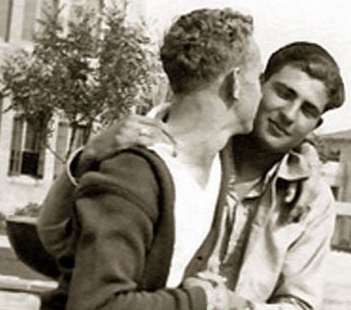

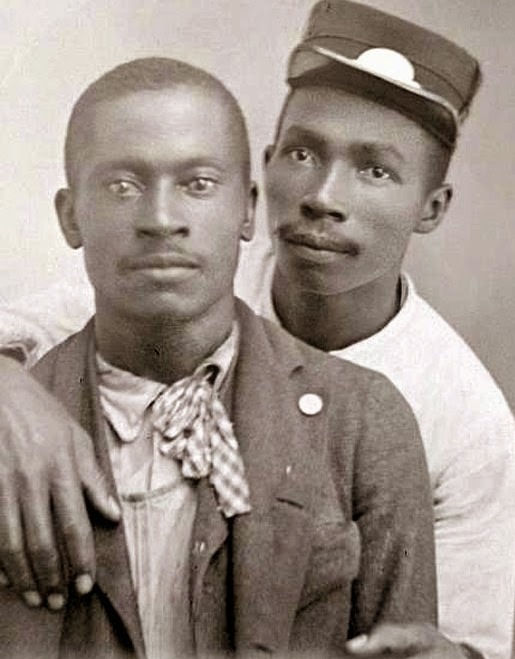
In the past, there were a
variety of terms, now archaic, that were in popular use
when discussing homosexuals and homosexuality…
Homophile, Invert, Pederast, Catamite, Sodomite,
Sapphist, Tribade, Bardash, Uranian.
In modern
times, terms
like "gay" or "queer" are used regularly, and with civil
tones. In the past, there were many slang and
pejorative expressions among American, British, and
French speakers that referred to homosexuals and
homosexuality… Homo, Fairy, Faggot (Fag), Gay Blade,
Dyke, Lesbo, Fruit, Queen, Swish, Flit, Bent, Pansy,
Camp, Auntie, Molly, Nancy (Nance, Nancyboy), Mary,
Nellie. Other descriptors included Limp Wrist
(American), Shirtlifter (Australian), Poof (British),
Light in
the Loafers, and Friend of
Dorothy (Reference to Wizard of Oz). Sissy
referred to feminine men and boys. Tommy (Tom
Boy) referred to masculine women and girls. Pillow
Biter (for gay men) and Carpet
Muncher (for lesbians).
Before
1967, male homosexuality was illegal in Britain. Because
even mentioning someone was a homosexual was so
offensive at the time in England, people who were
thought to be gay were referred to as “sporty” with
girls and “artistic” for boys.
Wikipedia: Camp
Homophile Terminology and Movement Explained
Thought Catalog: Gay Slang Phrases
Gay Dictionary
Encyclopedia of Homosexuality
Queers, Fags, Hussies and Catamites
Info:
LGBTQ Slang and Jargon
Wikipedia: Ganymede
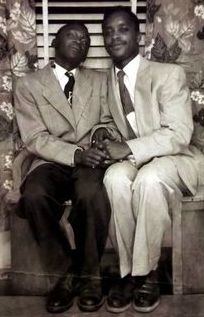
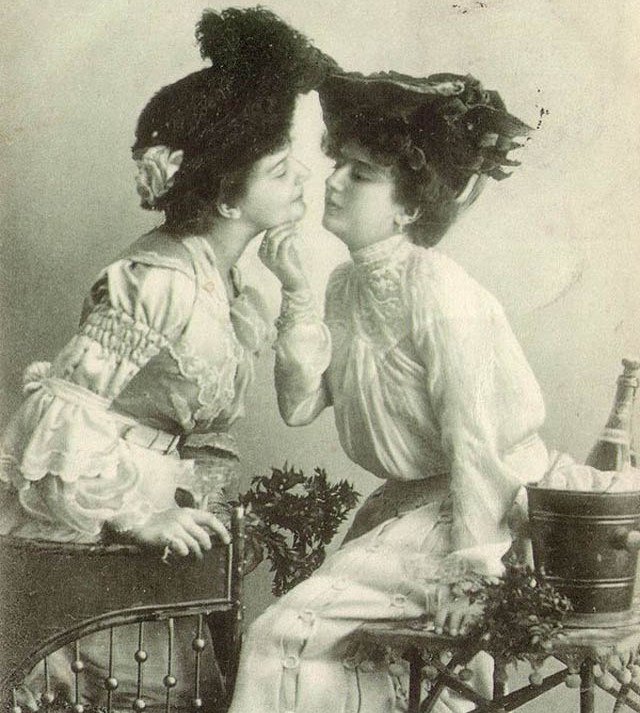
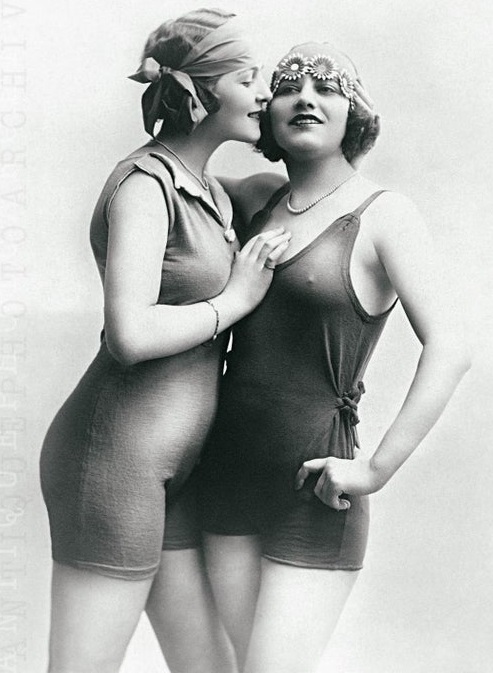 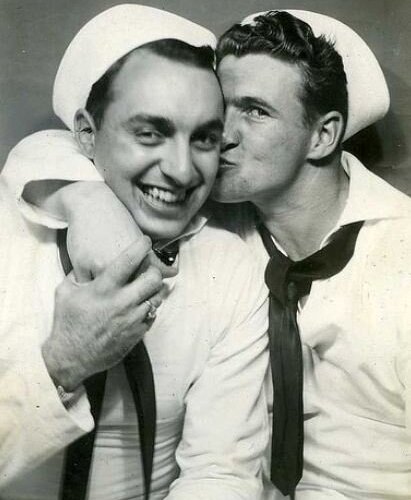
Antique Origins
The word “homosexual"
appeared in 1869 in a pamphlet published by Karl-Maria
Kertbeny. The word “homosexual” appeared again in 1892
in CG Chaddock's translation of Krafft-Ebing's
Psychopathia Sexualis.
“Homosexual” was first
used in general discourse as a noun in 1907 in French,
in 1912 in English. The slang shortened form “homo”
first appeared in 1929. The alternative “homophile” was
coined in reference to the homosexual as a person of a
particular social group, rather than a sexual
abnormality, in 1960, but it didn't catch on. The term
“homophobia” dates from 1969.
What about the word
“gay?” 1951 is usually given as the earliest date for
this slang term meaning "homosexual." Homosexuals,
among themselves, used the word “gay” in this sense
since at least 1920.
“Lesbian” dates to 1591,
from the Greek “Lesbos.” Lesbos is a Greek island in
northeastern Aegean Sea. Lesbos was the home of Sappho,
the great lyric poet of erotic and romantic verse. The
meaning, "relating to homosexual relations between
women," dates from 1890.
“Lesbianism,” on the
other hand, dates from 1870 and the noun “lesbian” in
this sense was first recorded in 1925.
History
of Gay and Other Queer Words
Homophile Movement
NY Times: Decline and Fall of the H Word
I Wish I Were a Fairy
Historic Photos of Men in Love: 1850s to 1950s
Info:
LGBTQ Slang and Jargon
Iconic Same-Sex Couples Throughout History / Part 1
Wikipedia: Pederasty
LGBTQ Nation: Old Timey Words for Gay and Lesbian
Homosexual Men
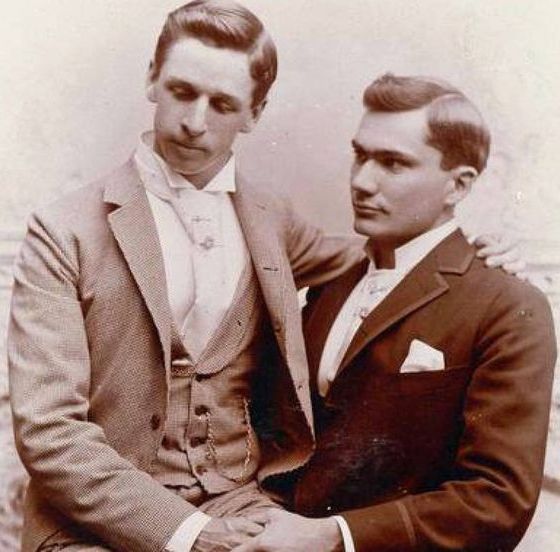
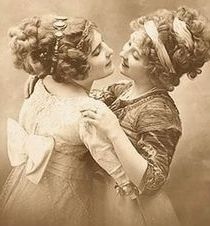
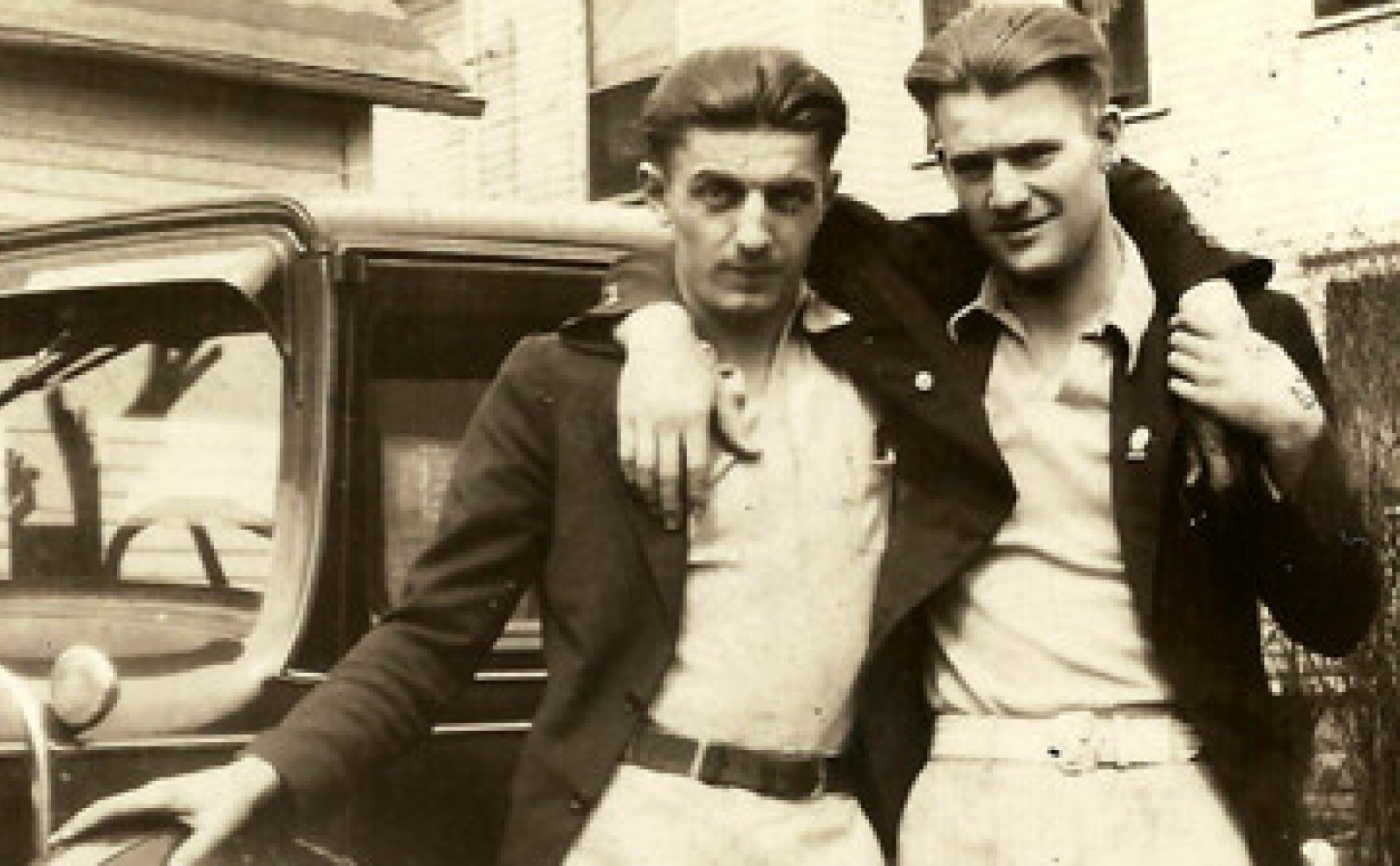
Outdated
Terminology
Homophile: The words
homophile and homophilia are outdated terms for
homosexuality. The use of the word began to disappear
with the emergence of the gay liberation movement of the
late 1960s and early 1970s, replaced by a new set of
terminology that provides a much clearer identity such
as gay, lesbian, bisexual, and transgender.
Pederast (Pederasty):
Describes an erotic or homosexual relationship between
an adult male and a pubescent or adolescent male. The
word pederasty derives from Greek meaning "love of
boys.” In French, it has been used as a synonym for
homosexuality between adult males.
Dyke: 1931, American and
British. Probably a shortening of “morphadike,” a
dialectal garbling of “hermaphrodite.” Bulldyke as a
noun dates from 1926. A source from 1896 lists “dyke”
as slang for "vulva."
Faggot: Reference to male
homosexuals, dates from 1914. The shortened form “fag”
dates from 1921.
Advocate: Old Timey Names for Gay People
Wikipedia: Sissy
Queer Terminology: LGBTQ Histories and
Semantics of Sexuality
Info: LGBTQ Historical
Perspectives
Wikipedia: Uranian
18th Century Homosexual Terms
Wikipedia: Terminology of Homosexuality
Swish: The sense of
"effeminate homosexual" dates from the 1930s in
homosexual slang. Imitative of the sound made by
something brushing against something or the sight of a
dramatic arm gesture or body movement.
Flame: The meaning
"sweetheart" is attested from 1647. The figurative sense
of "burning passion" was in Middle English. “Flamer” and
“flaming” (glaringly homosexual) are slang terms from
the 1970s, but “flamer” as "glaringly conspicuous person
or thing" (1809) and “flaming” as "glaringly
conspicuous" (1781) are much earlier in the general
sense. Perhaps also shorthand for “flamboyant.”
Sodomite (Sodomy):
Generally refers anal or oral sex between people or
sexual activity between a person and an animal
(bestiality). It may also mean any non-procreative
sexual activity. Originally, the term “sodomy,” which is
derived from the story of Sodom and Gomorrah in the
Biblical Book of Genesis, was commonly restricted to
anal sex.
Bugger
(Buggery): 1533, British. Very close in meaning to the
term "sodomy." Often used interchangeably in law and
popular speech. It may also be a specific common law
offence encompassing both sodomy and bestiality.

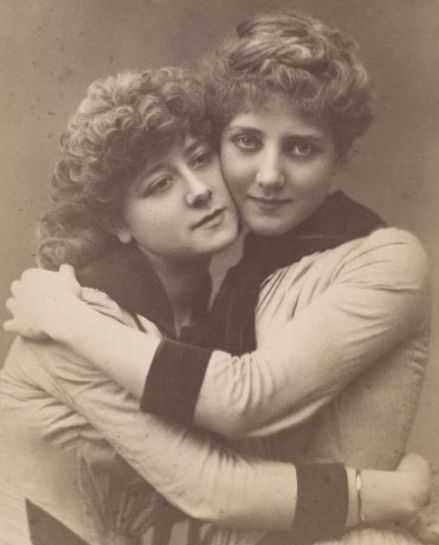
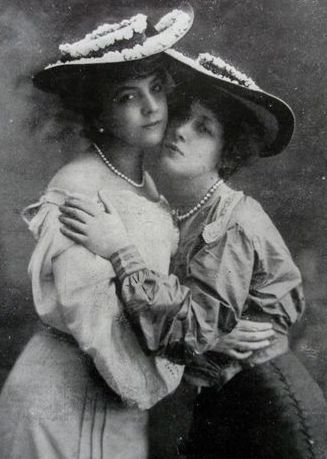
Info: LGBTQ Terminology
Wikipedia: Sissy
Homophile Movement
Old Timey Photos of Defiant Lesbians
Photos of Men in Love From 1845 to 1955
1950s Film:
Education on Homosexuals
Vintage Ads That Are Unintentionally Gay
Newsweek: Old
Curse Words
What Does “Fruity” Mean?
Info: Offensive Terms and Language
Old
School
--Sapphist (Sapphism): Term
applied to lesbians. Reference to the Greek poet Sappho.
The female equivilent of "sodomite."
--Flit:
1951. Term used to refer to homosexuals. From
JD Salinger's Catcher in the Rye.
--Poof (Poofter): 1850,
British. Used as a disparaging term for effeminate or
gay men.
--Nancy (Nance, Nancyboy):
1904. Used as a disparaging term for effeminate or gay
men.
--Bardash (Berdache): French.
Homosexual male. A kept male in a homosexual
relationship. (Similar to catamite)
--Folles: French.
Mad or crazy woman. Also a slang term
for effeminate homosexuals (queens).
--Ponce: 1872, British. Pimp. A man supported by women. Meaning "male
homosexual" by WH Auden in 1932.
--Pansy: 1929. Used as a
disparaging term for effeminate or gay men.
--Fairy: The meaning
"effeminate homosexual male" is first recorded in 1895.
Originally means “enchantment, magic.”
--Fruit: "Odd person,
eccentric," 1910. "Male homosexual," 1935.
--Queen: Male homosexual,
especially a feminine and ostentatious one. First
recorded in 1924.
--Tranny: Transgender person.
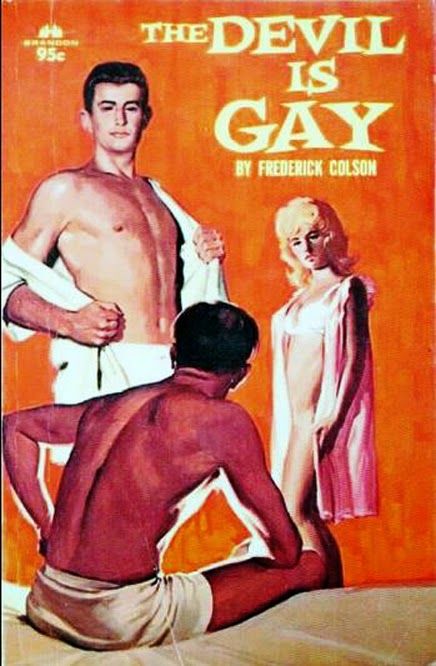


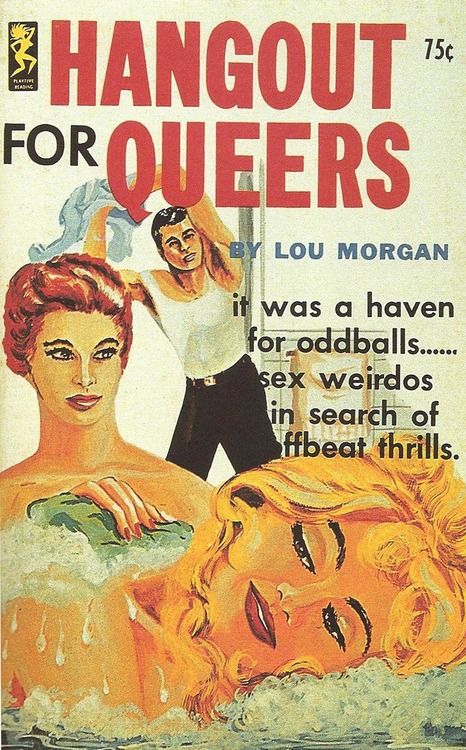
Old-Timey Names for 'Gay'
Iconic Photos of LGBTQ History
Vintage Gay Photos Taken at the Dawn of Photography
Rare Gay Motorcycle Club Photos From 1962
Info: LGBTQ Historical
Perspectives
Photos of Men in Love: 1850s-1950s
Stanford Encyclopedia: Homosexuality
Larry Houston:
Gay Research
Homosexual
Men
Antique
Terms
Camp: 1909 slang term for
homosexual style. It is an aesthetic style and
sensibility that regards something as appealing because
of its bad taste and ironic value. It is also considered
a performance identity for types of entertainment that
include cabaret, burlesque, parody, mockery, lampoon,
and drag. Where high art necessarily incorporates beauty
and value, camp necessarily needs to be lively,
audacious and dynamic. As an art form, “camp” or
“campy” may be described as kitschy, cheesy,
ostentatious, flamboyant, exaggerated, affected,
theatrical, or excessive.
Catamitus: Corrupt Latin
spelling of Ganymedus, who was Jupiter's beloved
cup-bearer. It came to mean the younger partner in a
pederastic relationship between two males. In Greek
mythology, Ganymede is a divine hero from Troy. In one
version of the myth, he is abducted by Zeus, in the form
of an eagle, to serve as cup-bearer (wine-pourer) in
Olympus. Homer describes Ganymede as the most beautiful
of mortals. The myth was a model for the Greek social
custom of paiderastía, the socially acceptable erotic
relationship between an adult male and an adolescent
male. The Latin form of the name was Catamitus (and also
"Ganymedes"), from which the English word "catamite" is
derived.
Calamus: This word
derives from the Greek “kalamos,” meaning “reed,” and by
extension a flute, fishing rod, and a reed pen. From the
latter usage stems the Latin “lapsus calami,” meaning “a
slip of the pen.” Walt Whitman entitled the most overtly
homoerotic and self-revealing section of Leaves of
Grass, "Calamus." He was thinking of one particular
variety of plant, the sweet flag (acorus calamus), as a
symbol of male-male affection. It must have appealed to
him also because of the traditional association of the
calamus (reed pen) with the writer's profession. Yet,
from Greek mythology he may have known the story of
Calamus, the son of a river god, who was united in
tender love with another youth, Carpus. When Carpus was
accidentally drowned, the grief-stricken Calamus was
changed into a reed.
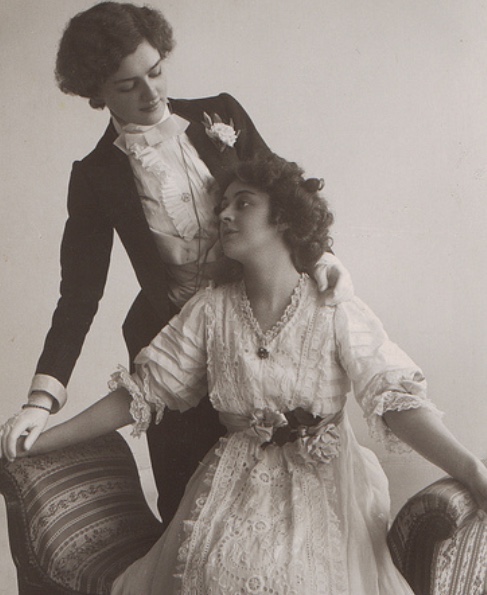

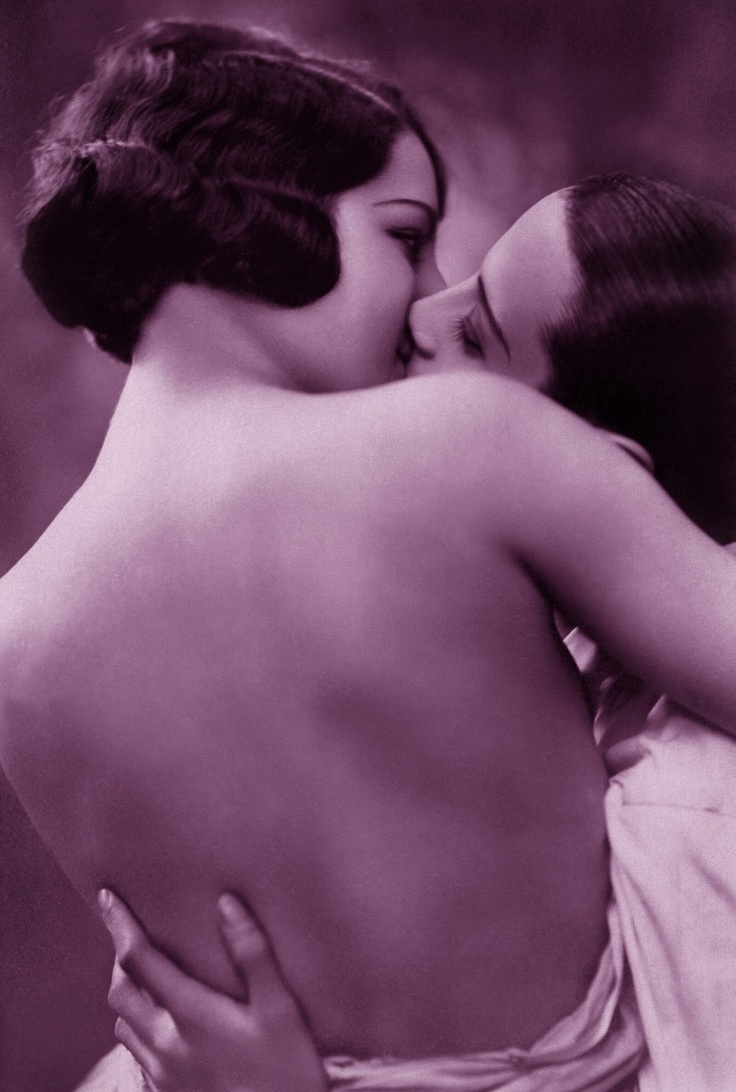
What Does “Fruity” Mean?
Homosexuality in London Criminal Courts 1674-1913
Iconic Same-Sex Couples Throughout History / Part 2
Vintage Photos of LGBTQ Couples
Advocate: Old Timey Names for Gay People
Adorable Vintage Photos Of Gay Couples
Queer Terminology:
LGBTQ
Histories and the Semantics of Sexuality
Uranian (Uranism, Uranist,
Urning): 19th-century term that referred to a person of
a third sex. Originally it referred to someone with a
female psyche in a male body who is sexually attracted
to men, and later extended to cover homosexual gender
variant females, and a number of other sexual types. It
is believed to be an English adaptation of the German
word “urning,” which was first published by activist
Karl Heinrich Ulrichs (1825–1895) in a series of five
booklets which were collected under the title
Research into the Riddle of Man-Male Love. Ulrichs
developed his terminology before the first public use of
the term "homosexual.” The word “Uranian” (and “Urning”)
was derived by Ulrichs from the Greek goddess Aphrodite
Urania, who was created out of the god Uranus'
testicles. Therefore, it stands for homosexual gender,
while Aphrodite Dionea (Dioning) represents the
heterosexual gender.
Sissy: Effeminate boy or
man, with connotations of being homosexual or a coward.
Pejorative term for a boy or man who does not conform to
standard male gender stereotypes. Generally, "sissy"
implies a lack of courage, strength, athleticism,
coordination, testosterone, male libido, and stoic calm,
all of which have traditionally been associated with
masculinity and considered important to the male role in
Western society. A man might also be considered a
"sissy" for being interested in traditionally feminine
hobbies or employment (being fond of fashion),
displaying effeminate behavior (using hair products or
displaying limp wrists), being unathletic, or being
homosexual. (Similar to pansy, nancyboy, poof)
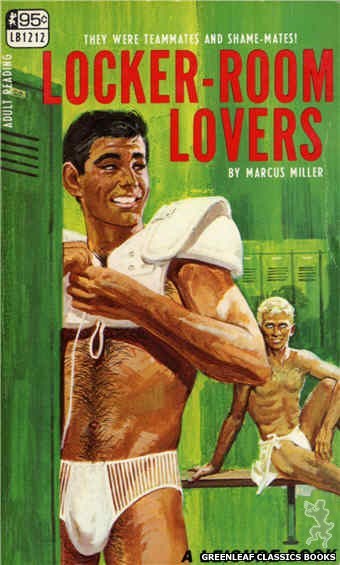
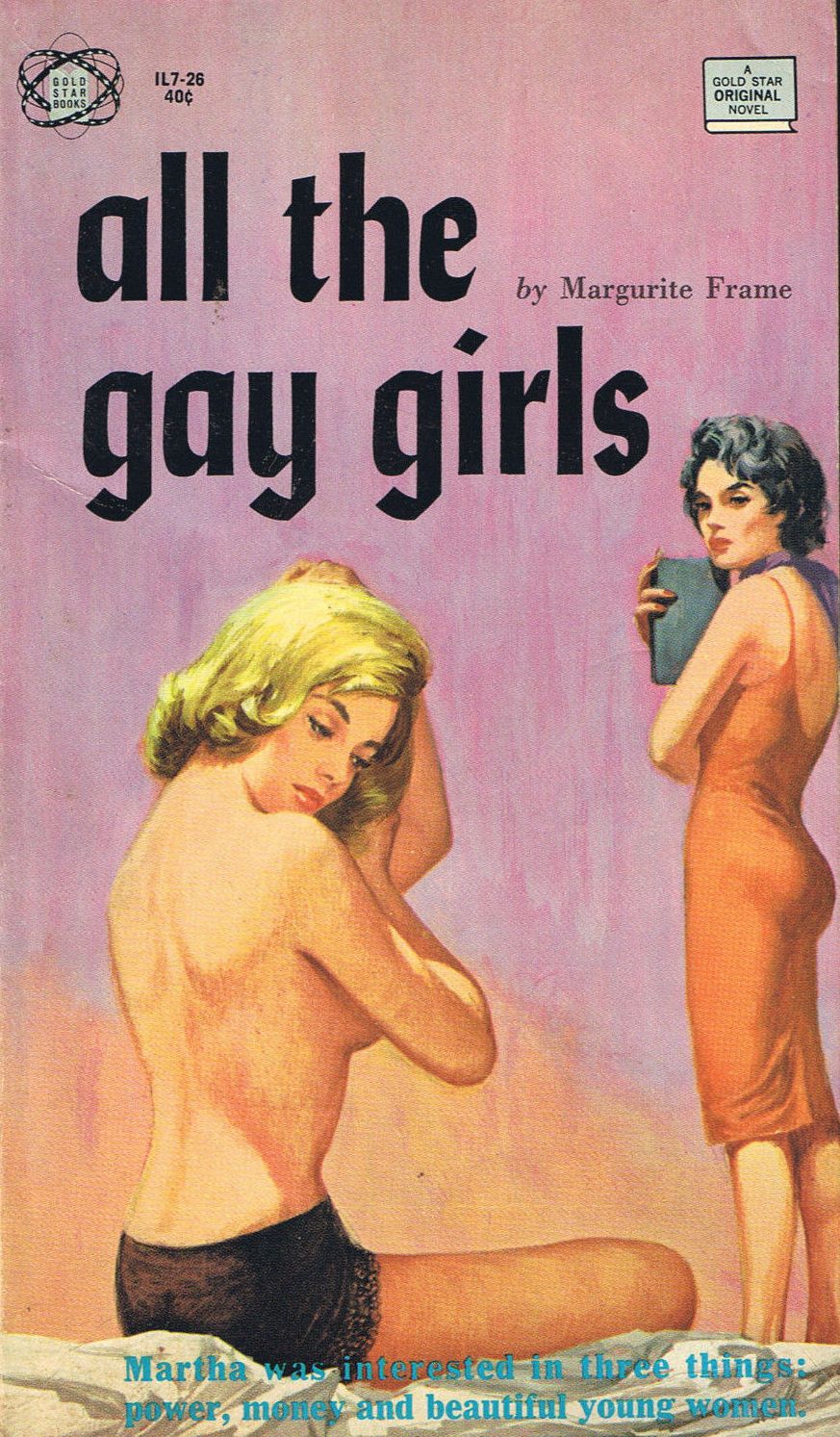
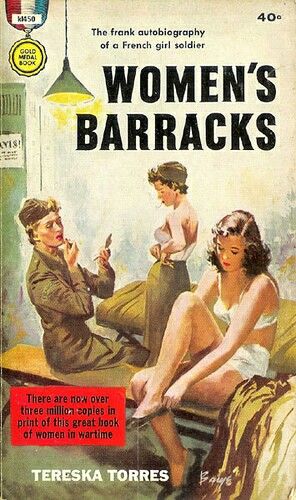
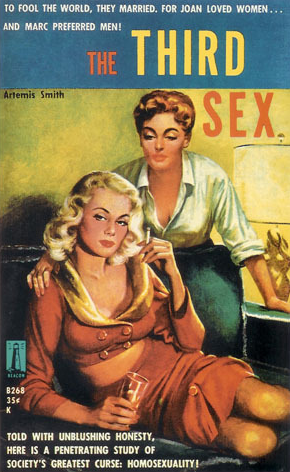
Diversity Inc: LGBTQ
Historical Timeline
The Rise of a Gay and
Lesbian Movement
Info: LGBTQ Symbols
LGBTQ History Can Be Found in Everyone's Past
Photos of Men in Love:
1850s-1950s
Wikipedia: Camp
Info: LGBTQ Terminology
Old-Timey Names for 'Gay'
Newsweek: Old
Curse Words
Wikipedia: Pederasty
LGBTQ Nation: Old Timey Words for Gay and Lesbian
Invert/Inversion
Invert is a psychological
term referring to a person displaying sexual inversion.
Sexual inversion was a term used by sexologists,
primarily in the late 19th and early 20th century, to
refer to homosexuality. Sexual inversion was believed to
be an inborn reversal of gender traits: male inverts
were, to a greater or lesser degree, inclined to
traditionally female pursuits and dress and vice versa.
The sexologist Richard von Krafft-Ebing described female
sexual inversion as "the masculine soul heaving in the
female bosom.”
Initially confined to
medical texts, the concept of sexual inversion was given
wide currency by Radclyffe Hall's 1928 lesbian novel
The Well of Loneliness, which was written in part to
popularize the sexologists' views. Published with a
foreword by the sexologist Havelock Ellis, it
consistently used the term "invert" to refer to its
protagonist, who bore a strong resemblance to one of
Krafft-Ebing's case studies.
In its emphasis on gender
role reversal, the theory of sexual inversion resembles
transgender, which did not yet exist as a separate
concept at the time. According to this theory, gay men
and lesbians were sexual "inverts", people who appeared
physically male or female on the outside, but felt
internally that they were of the "opposite" anatomical
sex (according to the binary view of gender). Therefore,
same-gender desires and attraction were explained as
"latent heterosexuality", and bisexual desire was known
as psychosexual hermaphroditism. In other words, gay men
and lesbians were really just heterosexuals who were
"born in the wrong body", and "bisexuals" were what
modern-day sexologists would call “intersex” persons
(formerly hermaphrodites).
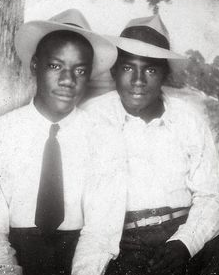
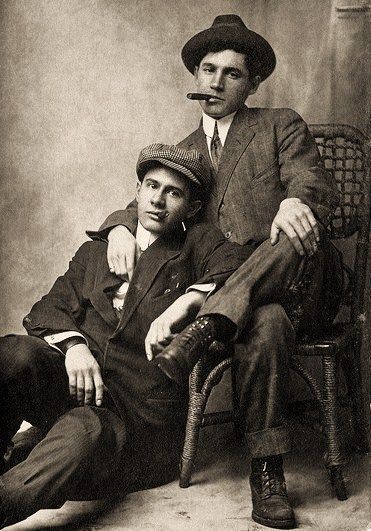
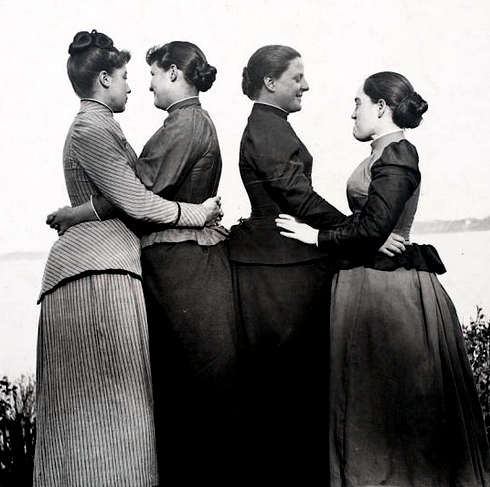
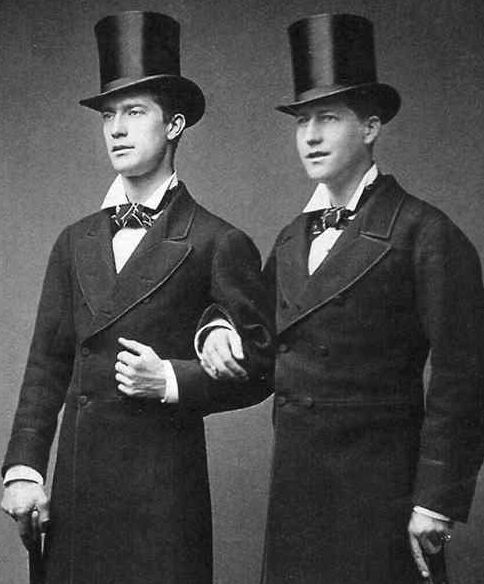
History
of Gay and Other Queer Words
Homophile Movement
NY Times: Decline and Fall of the H Word
Info:
LGBTQ Slang and Jargon
Old Timey Film:
Beware of the Homosexuals
Vagina Terms: Historical Slang
Historic Photos of Men in Love: 1850s to 1950s
Researching LGBTQ Ancestors
Info: Offensive Terms and Language
Vintage Ads That Are Unintentionally Gay
Photos of Men in Love From 1845 to 1955
Newsweek: Old
Curse Words
Wikipedia: Tribidism
Hermaphrodite
Historically, the term
"hermaphrodite" has been used to describe
ambiguous genitalia in animals and human beings. The
word “intersex” has come into preferred usage for
humans, since the word “hermaphrodite” is considered to
be misleading, stigmatizing, scientifically specious,
and clinically problematic.
The term derives from the
Latin “hermaphroditus,” from Ancient Greek, the name of
the son of Hermes (messenger god) and Aphrodite (goddess
of love) in Greek mythology. He was said to possess the
physical traits of male and female sexes. He was born
with a physical body combining male and female sexes.
The word “hermaphrodite” entered the English lexicon as
early as the late fourteenth century.
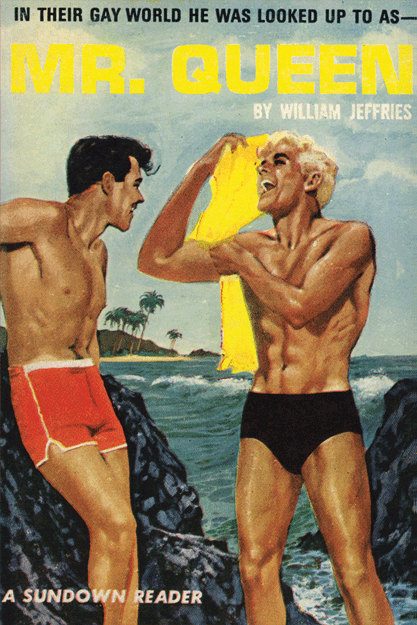

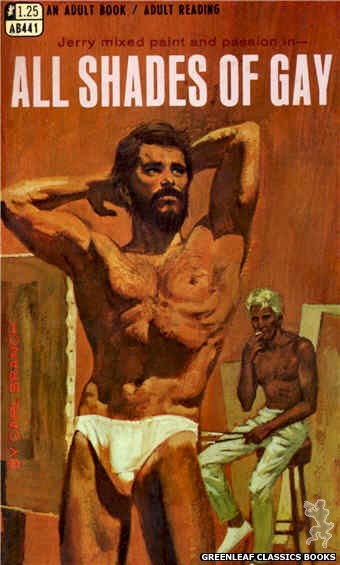
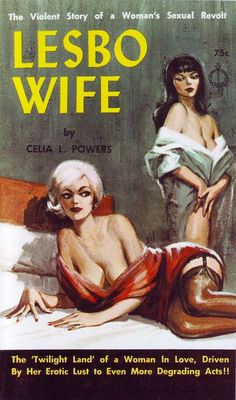
Info: Offensive Terms and Language
Great Queers of History
Important LGBTQ Moments in US History
Cheesecake and Beefcake
What Does “Fruity” Mean?
A Movement Caught Hold and Has Never Let Go
Info: LGBTQ Historical
Perspectives
APA: History of LGBTQ Social Movements
Wikipedia: Ganymede
Vintage Gay Photos Taken at the Dawn of Photography
Info:
LGBTQ Slang and Jargon
Iconic Photos of LGBTQ History
Tribade/Tribadism
"Tribade" is a term applied to
lesbians, as in “one who engages in tribadism”.
Sometimes translated as “rubster.” The terms “tribadism”
or “tribbing,” commonly known by its scissoring
position, is a sex act in which a woman rubs her vulva
against her partner's body for sexual stimulation, which
may involve female-to-female genital contact. The term
“tribadism” is usually used in the context of lesbian
sex. In modern times, the term typically refers to
various forms of non-penetrative sex (or frottage)
between women.
The Greek term for
lesbian, “tribas,” comes from the verb “tribein,”
meaning "to rub,” implying that the women so designated
derive their sexual pleasure from friction against one
another's bodies.
Based on the Greek
expression, the Latin language formed its own word “frictrix,”
from “fricare,” meaning "to rub.”
In the mid 19th
century, the term “lesbian” gradually supplanted
“tribade” (and “sapphist”) in learned and popular usage,
so that today the word occurs but rarely as a deliberate
archaism or classical allusion.
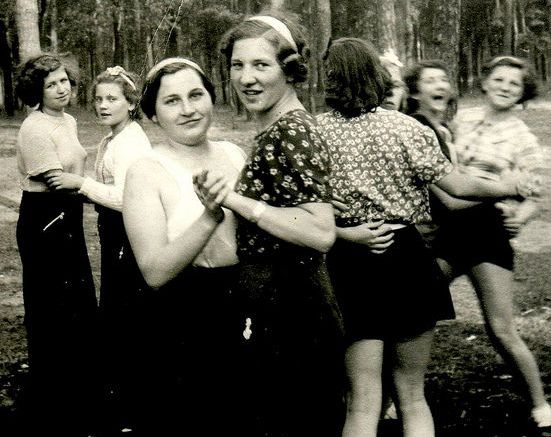
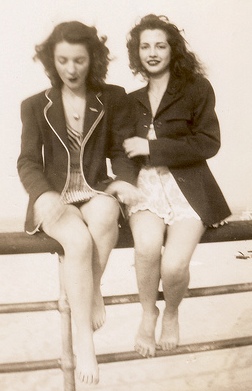

Iconic Photos of LGBTQ History
Thought Catalog: Gay Slang Phrases
Homosexual Men
I Wish I Were a Fairy
Rare Gay Motorcycle Club Photos From 1962
Vintage Ads That Are Unintentionally Gay
Encyclopedia of
Homosexuality
Info:
LGBTQ Slang and Jargon
Adorable Vintage Photos Of Gay Couples
Transvestite/Transvestism
Transvestism is the practice of dressing and acting in a style or manner
traditionally associated with the opposite sex. Though
coined as late as the 1910s (by Magnus Hirschfeld), the
phenomenon is not new. Today, the term “transvestite” is
commonly considered outdated and derogatory, with the
term “cross-dresser” used as a more appropriate
replacement. The term “transvestite” was historically
used to diagnose medical disorders, including mental
health disorders, and “transvestism” was viewed as a
disorder, but the term “cross-dresser” was adopted. The
word “transvestite” derives from the Latin “trans,”
which means “across, over" and “vestitus,” which means
"dressed.” It was used to describe persons who
habitually and voluntarily wore clothes of the opposite
sex.
“Transvestite” should not
be confused with “transgender” or “transsexual.”
Transvestites are often happy with their gender and have
no desire to change their sex, but simply enjoy being
able to cross-dress from time to time. The term should
also not be confused with “drag queen,” which refers to
a male who wears women’s clothing for public performance
and entertainment.
Info: LGBTQ Terminology
LGBTQ Historical Overview
Rare Gay Motorcycle Club Photos From 1962
Old-Timey Names for 'Gay'
Vintage Ads That Are Unintentionally Gay
I Wish I Were a Fairy
Fight for LGBTQ Rights Throughout History
Info: Offensive Terms and Language
Gay History Quiz
Photos of Men in Love: 1850s-1950s
Buzzfeed: This is What
Gay Liberation Looked Like in the 70s
Info:
Famous LGBTQ People
CNN: LGBTQ Rights Milestones and Fast Facts

Transgender
Terms and Labels
Let's examine some outdated, inaccurate, or offensive
gender identity terms. Although some people may use the
following terms to describe their own gender, most of
the labels below range from out-of-date to offensive.
Archaic
terms for transgender people included Tranny and Shemale.
And terms like Transgendered and Transsexual are
considered inaccurate and out-of-date.
Archaic: Gender Identity Disorder (or GID)
Preferred: Gender Dysphoria
Archaic: Hermaphrodite
Preferred: Intersex
Archaic:
Sex Change Operation
Preferred: Sex Reassignment Surgery (SRS) or Gender
Affirming Surgery
Adorable Vintage Photos Of Gay Couples
Wikipedia: Terminology of Homosexuality
Info: Offensive Terms and Language
Photos of Men in Love From 1845 to 1955
What Does “Fruity” Mean?
Vintage Gay Photos Taken at the Dawn of Photography
Larry Houston: Gay Research
Homosexual Men
Info: LGBTQ Historical
Perspectives
Stanford Encyclopedia: Homosexuality
Sexual Aberration
The notion of sexual
aberration had some currency in the literature of
psychiatry during the first half of the 20th century.
Although the expression encompassed a whole range of
behaviors regarded as abnormalities, it is probably safe
to say that it was used more with reference to
homosexuality than for any other "disorder." In due
course it yielded to less negative terms like
“deviation” and “deviance.”
The term “aberration”
derives from the Latin “aberrare,” which means "to go
astray, wander off." For 19th alienists and moralists,
the word aberration took on strong connotations of
mental instability or madness. Thus, in its application
to sexual nonconformity, the concept linked up with the
notion of "moral insanity," that is to say, the
nonclinical manifestation of desire for variant
experience. The proliferation of such terms in the
writings of psychiatrists, physicians, moralists, and
journalists in the first half of the 20th century
reveals a profound ambivalence with regard to human
variation, in which prescriptive condemnation struggles
with, and often overcomes, descriptive neutrality.
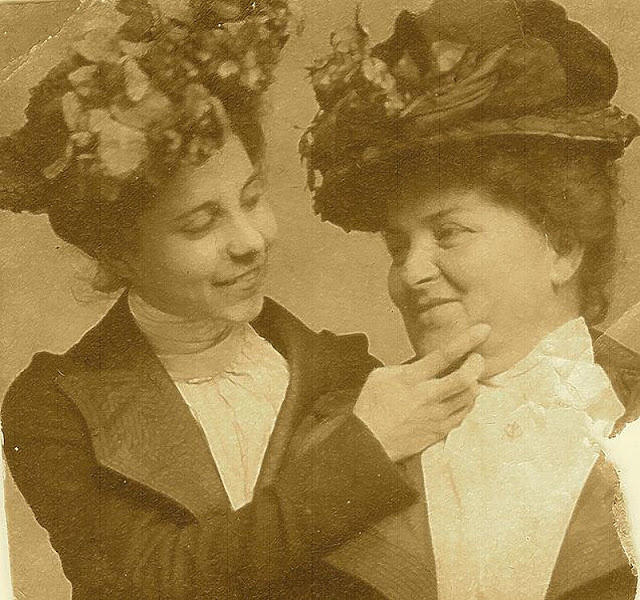
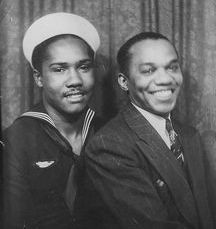
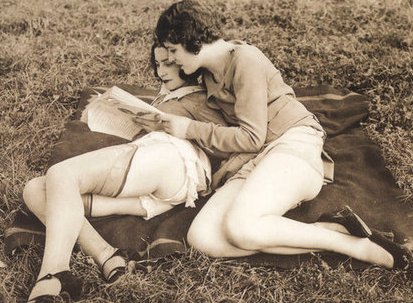
A Movement Caught Hold and Has Never Let Go
I Wish I Were a Fairy
Info: LGBTQ Historical
Perspectives
APA: History of LGBTQ Social Movements
Old-Timey Names for 'Gay'
Historic Photos of Men in Love: 1850s to 1950s
Wikipedia: Ganymede
Info:
LGBTQ Slang and Jargon
Abomination
In contemporary usage the
terms “abomination” and “abominable” refer in a generic
way to something that is detestable or loathsome.
Because of Old Testament usage, however, the words
retain a special association as part of the religious
condemnation of male homosexual behavior: "Thou shalt
not lie with mankind as with womankind; it is
abomination (Leviticus 18:22)."
In Elizabethan English
they were normally written "abhomination" and "abhominable"
as if they derived from Latin “ab” and “homo,” meaning,
"departing from the human or inhuman." In fact, the core
of the Latin word is the religious term “omen.”
In any event the notion
of abomination owes its force to its appearance in
Jerome's Vulgate translation of the Bible, where it
corresponds to Greek “bdelygma” and Hebrew “tó'ebáh.”
The latter term denotes behavior that violates the
covenant between God and Israel, and is applied to
Canaanite trade practices, idolatry, and polytheism. The
aversion of the religious leaders of the Jewish
community after the return from the Babylonian captivity
to the "abominable customs" of their heathen neighbors,
combined with the Zoroastrian prohibition of homosexual
behavior, inspired the legal provisions added to the
Holiness Code of Leviticus in the 5th century
before the Christian era that were to be normative for
Hellenistic Judaism and then for Pauline Christianity.
The designation of homosexual relations as an
"abomination" or "abominable crime" in medieval and
modern sacral and legal texts echoes the wording of the
Old Testament.
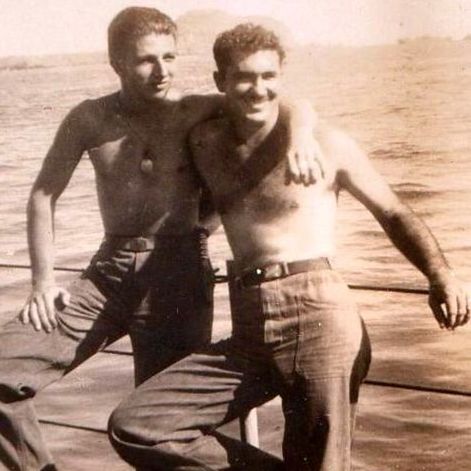
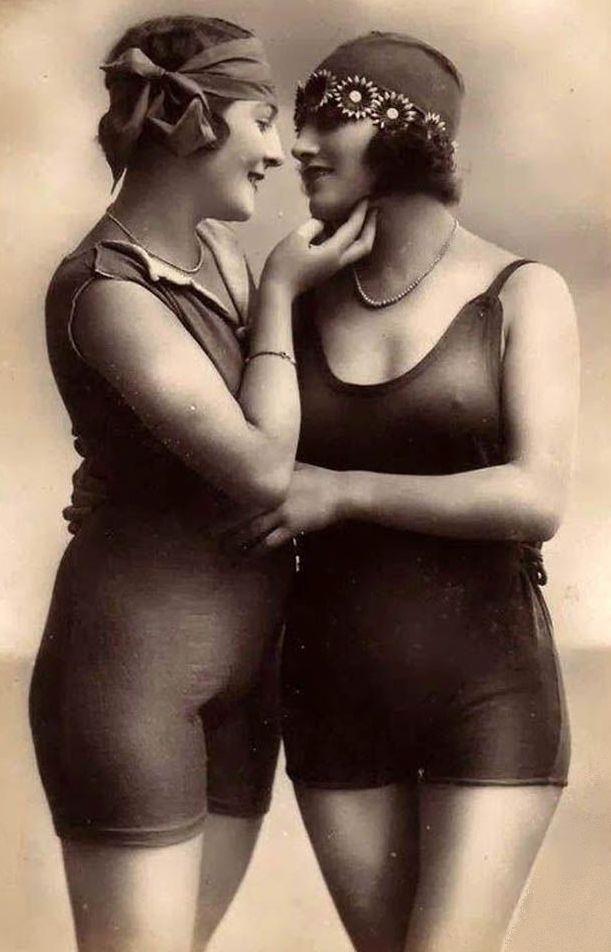
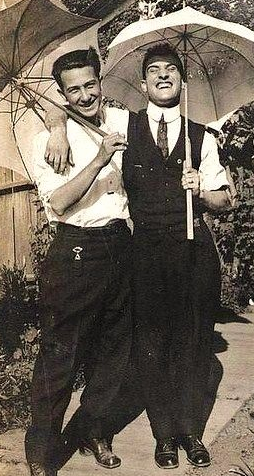
Advocate: Old Timey Names for Gay People
Wikipedia: Sissy
Queer Terminology: LGBTQ Histories and
the Semantics of Sexuality
Info: LGBTQ Historical
Perspectives
Old Timey Photos of Defiant Lesbians
Wikipedia: Uranian
18th Century Homosexual Terms
Newsweek: Old
Curse Words
Contrary Sexual Feeling
The expression “contrary
sexual feeling” is the English rendering of the
overarching term adopted by the German physician Karl
Friedrich Otto Westphal (1833-1890) for the condition
that he had abstracted from two case histories under his
observation, one of a lesbian, the other of a male
transvestite.
Westphal judged the
condition (which came to be designated as homosexuality)
as inborn, a symptom of a neuropathic or psychopathic
state, as an alienation from the feeling proper to the
anatomical sex of the subject. He drew the forensic
distinction between exclusive and occasional
homosexuality, but his failure to separate the two
psychological entities that he had encountered was not
corrected until fifty years later, when Havelock Ellis
formulated the differential concept of eonism and Magnus
Hirschfeld that of transvestism, the latter on the basis
of 17 cases of heterosexual transvestism that he had
isolated from the 7,000 homosexual case histories he had
taken until that time.
The English abstractors
and translators of European psychiatric literature were
never able to decide upon a uniform equivalent for the
awkward German expression, "contrary sexual feeling" or
"contrary sexual instinct."
To the English-speaking
lay public, of course, the word "contrary," like
"perverse" conveyed a notion of the rebellious,
refractory, and antithetical, though such connotations
were not overtly recognized by specialists. In any event
the expression was not destined to survive. As early as
1870 an American psychiatrist preparing an abstract of
Westphal's article had used "inverted sexual feeling."
With appropriate modifications this term, simplified to
“sexual inversion,” was adopted in all the Romance
languages and in English as the medical designation for
what journalistic style was later to dub
“homosexuality,” a term invented by the apologist Karoly
Maria Kertbeny in 1869 and taken up by Gustav Jaeger in
the book Entdeckung der Seele in 1880.
Since the term
“homosexuality” fit perfectly into the international
nomenclature of Greek-Latin expressions and allowed for
a triptych with bisexual and heterosexual, it drove the
clumsy and eccentric coinages that had been proposed in
earlier decades out of use. So "contrary sexual feeling"
is the linguistic remnant of the first, uncertain
psychiatric attempt to grapple with the problem of
homosexuality.
[Source: Warren
Johansson, Encyclopedia of Homosexuality]
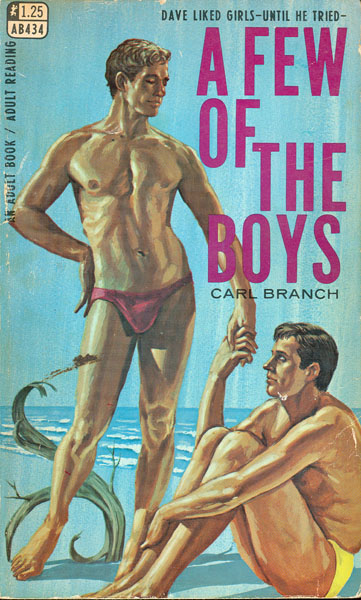
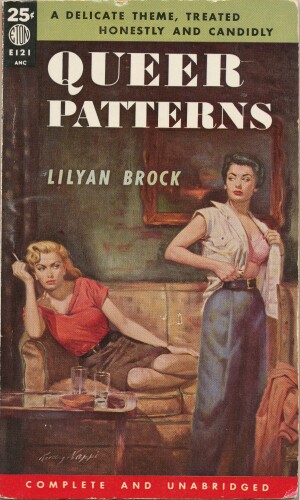
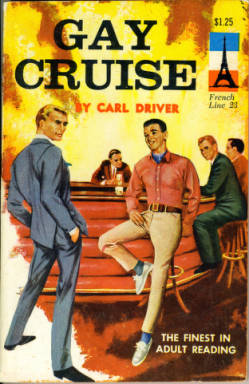
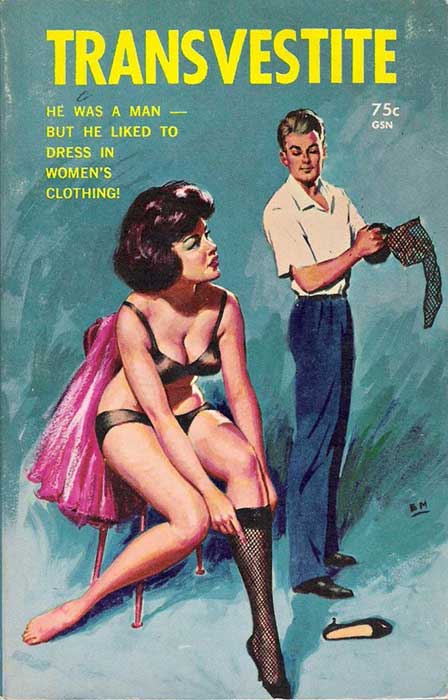
Old Timey Film:
Beware of the Homosexuals
Vagina Terms: Historical Slang
Historic Photos of Men in Love: 1850s to 1950s
Researching LGBTQ Ancestors
Info: Offensive Terms and Language
Vintage Ads That Are Unintentionally Gay
Photos of Men in Love From 1845 to 1955
Newsweek: Old
Curse Words
Wikipedia: Tribidism
Perversion
Historically,
“perversion” may be the most affect-laden, ambiguous,
and misleading term in the whole lexicon of the study of
sexual behavior. Webster's Third New International
Dictionary (1961) defined it as "Some form of sex
gratification preferred to heterosexual coitus and
habitually sought after as the primary or only form of
sex gratification desired."
Although the original
negativity of the word has weakened in recent decades,
it still retains the connotation of a departure from the
norm. Fortunately, most serious researchers recognize
the problematic character of the word and use it, if at
all, with caution.
“Perversion” entered the
semantic field of sexuality only in the last third of
the 19th century. Until then it had meant
simply "any qualitative alteration of a function in
disease." Against this background, "perversion of the
sexual instinct" meant a change in the direction of the
sexual desires, as opposed to a quantitative change
(satyriasis and nymphomania on the one hand, impotence
and frigidity on the other). The medical criteria for
perversion were its involuntary exclusiveness and
fixation. It was never asserted, as many laymen were to
assume, that all "perverse" behavior stemmed from
pathology, but only that certain individuals were in the
grip of an abnormal sexual orientation beyond their
control.
It was Richard von
Krafft-Ebing's ill-fated notion that the etiology of
perverse (non-procreative) sexual acts could be ascribed
to either pathology or to vice. This novel distinction
was important for the forensic psychiatrist because it
separated persons accused of sexual offenses who were
unwilling victims of inner compulsions from others who
willfully embraced illicit behavior and were therefore
responsible for their actions.
Though popularized in Krafft-Ebing's
best-selling Psychopathia
sexualis (1886), the distinction eluded the public mind,
all the more as there had been in classical Latin the
phrase “perversio morum” that left its imprint on the
modern languages in the form of "moral perversion."
Worse still, in English
the word “pervert” had from the middle of the 17th
century possessed the meaning "religious apostate," so
that in the mind of the English speaker the word easily
took on the sense of "one who willfully and obstinately
departed from the moral norm of sexual behavior."
Info: Offensive Terms and Language
Great Queers of History
Iconic Photos of LGBTQ History
Important LGBTQ Moments in US History
Cheesecake and Beefcake
Old Timey Photos of Defiant Lesbians
Abnormal
and Deviant Behavior?
Even in the academic
world, it can be somewhat shocking to discover the
archaic terminology that was once used to describe
homosexuals and homosexuality. “Abnormal Psychology”
was the name once given to the category of psychology
under which homosexuality was discussed. “Deviant
Behavior” was the name of the category of sociology
under which homosexuality was discussed.
Those in the field of
abnormal psychology study people's emotional, cognitive,
and behavioral problems. Abnormal behavior may be
defined as patterns of behavior that are unusual,
disturbing (socially unacceptable), distressing,
maladaptive (or self-defeating), and often the result of
distorted thoughts (cognitions), which may or may not be
understood as precipitating a mental disorder. It seeks
to understand behavior deemed to be aberrant or deviant
(statistically, functionally, morally).
In sociology, deviance
describes an action or behavior that violates social
norms, including a formally enacted rule (crime), as
well as informal violations of social norms (rejecting
folkways and mores). Norms are rules and expectations by
which members of society are conventionally guided.
Deviance is an absence of conformity to these norms.
Viewing deviance as a violation of social norms,
sociologists have characterized it as any thought,
feeling, or action that members of a social group judge
to be a violation of (or departure from) their values or
rules or group conduct, that violates definitions of
appropriate and inappropriate conduct shared by the
members of a social system.
In modern times,
researchers try to be sensitive to the LGBTQ population and
are careful in their use of such terms as "abnormal" and
"deviant."
Advocate: Old Timey Names for Gay People
Newsweek: Old
Curse Words
Queer Terminology: LGBTQ Histories and
the Semantics of Sexuality
Info: LGBTQ Historical
Perspectives
18th Century Homosexual Terms
Adorable Vintage Photos Of Gay Couples
Vintage Gay Photos Taken at the Dawn of Photography
Wikipedia: Terminology of Homosexuality
Info: Offensive Terms and Language
Vintage Ads That Are Unintentionally Gay
Larry Houston: Gay Research
Homosexual Men
HOME
QUEER CAFE
│ LGBTQ Information Network │ Established 2017 |